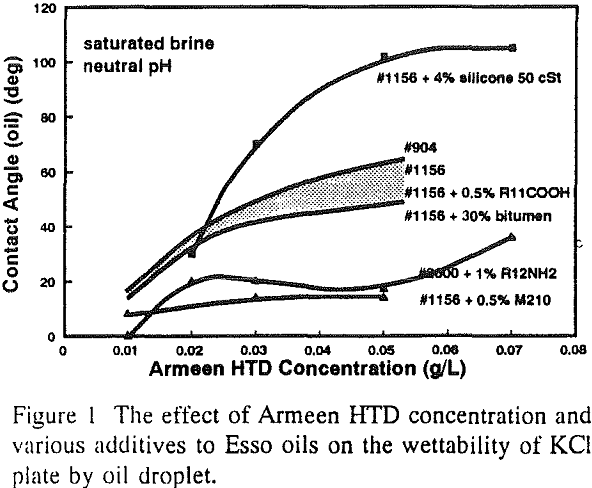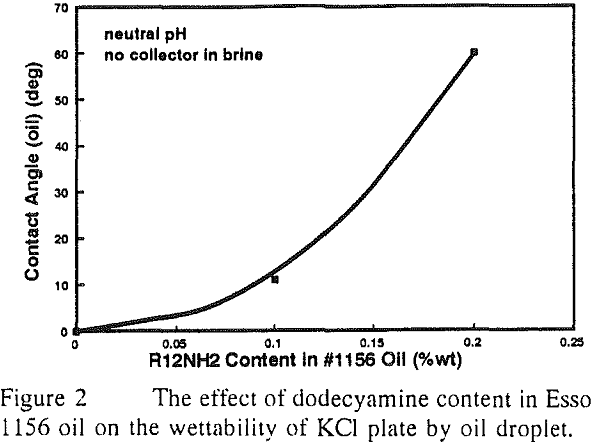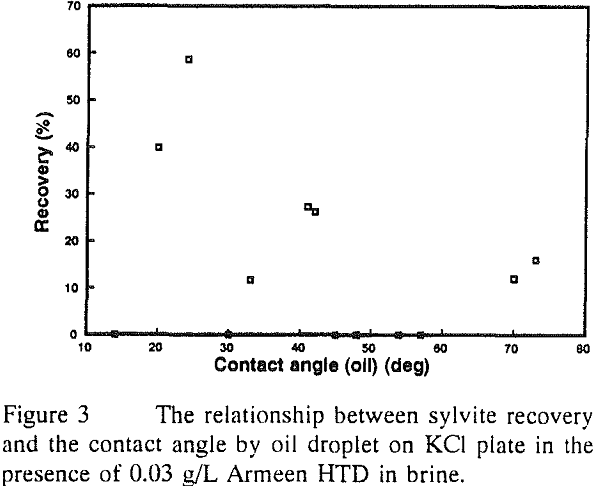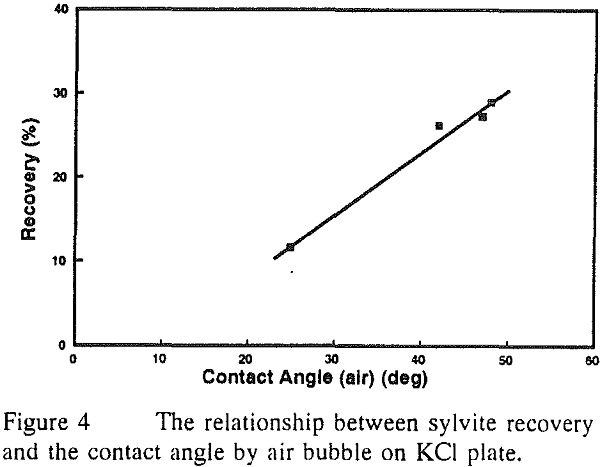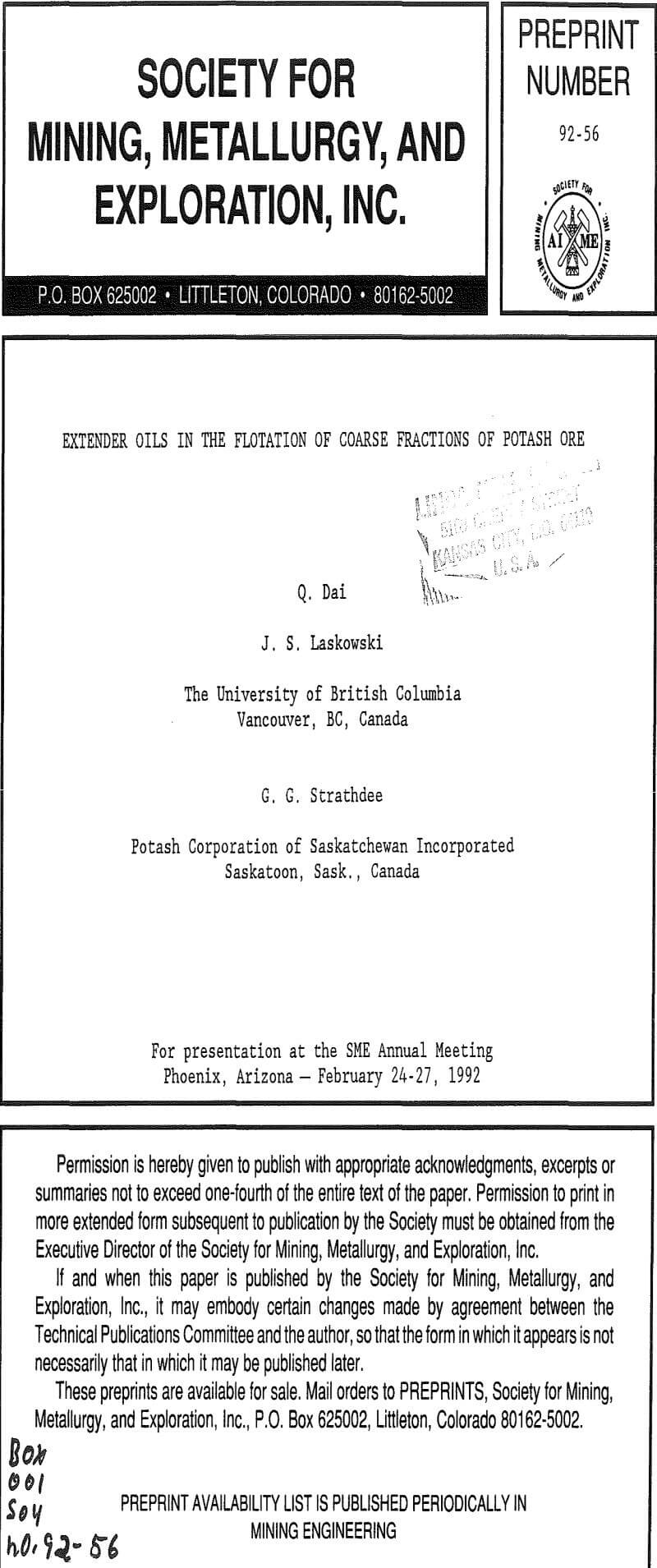In order to float coarse sylvite particles, Potash Corporation of Saskatchewan Inc. (PCS) uses amines and extender oil. Since the content of polycyclic aromatic (PCA) compounds in Esso 904 oil is high, PCS has sought a suitable replacement. Various types of physicochemical tests, including measurements of the electrokinetic potential of emulsified oil droplets, oil/water interfacial tension and wetting of KCl plates by oil, did not provide conclusive results.
In emulsion flotation (used to float inherently hydrophobic minerals), oil droplets attach and adhere in the conditioning stage to the particles which are hydrophobic to some extent and further improve their flotation. In potash flotation, sylvite particles are hydrophilic and so oil droplets can attach to the sylvite particles if they are rendered hydrophobic by amine. While fine sylvite particles can be floated with amines only, an extender oil is required in addition to amine to float coarse sylvite fractions.
Oils tested in this study included Esso 904, 1156, 2600 oils, etc. Esso 904 oil is a mixture of 55%wt Ex- 466 oil and 45%wt Esso 1156 oil. Ex-466 oil is a catalytic cracking bottom residue. Esso 1156 oil is a light gas oil of predominantly aromatic hydrocarbons and is of low viscosity, and Esso 2600 oil is a viscous oil consisting of mostly paraffinic hydrocarbons with a high level of polar compounds.
Droplets of Esso 904 oil (55% Ex-466) were more positively charged and had a higher isoelectric point value than Esso 1156 oil droplets (0% Ex-466), indicating the presence of heteropolar surface active substances in Ex- 466 oil.
The oil/brine interfacial tension measurements provide another means of characterizing oils since any content of polar compounds in oil lowers the interfacial tension value.
It was found that, while the interfacial tension for Esso 1156 oil remained high over the pH range of pH 4-9, in the case of Esso 904 it began to decrease rapidly at neutral pH values and dropped to very low values in the alkaline pH range. This clearly indicates the presence of polar compounds in the heavy Esso 904 oil.
From the above results, it is seen that the zeta potential of oil droplets and the oil/brine interfacial tension are not directly related to the wetting ability of oil. For instance, irrespective of the difference in the zeta potential and interfacial tension values between Esso 904 oil and 1156 oils, the two oils provided similar θoil) values. Also, Esso 904 oil has a superior wetting ability to Esso 1156 oil containing M210 promoter, yet both exhibit similar electrokinetic properties.
The flotation tests were performed at the Potash Corporation of Saskatchewan. In order to identify the oils superior to Esso 904, the feed size was intentionally increased. As a result, low recoveries were experienced in a standard batch flotation experiment. The mean recovery achieved with Esso 904 oil was 27.3%; Esso 2600 oil exhibited a similar collecting power to Esso 904 oil, while Esso 1156 oil provided much lower recoveries.
Since the zeta potential and the interfacial tension are sensitive to the variation in oil composition, these properties were measured to examine what makes Esso 904 oil so unique and under which conditions other oils may assume the same interfacial properties as Esso 904 oil. While such tests are helpful in characterizing different oils and furnishing information useful for the oil modification, the information on the interfacial properties of oil turned out to be insufficient for the prediction of the oil’s wetting and collecting properties in potash flotation.
Unlike the emulsion flotation where a large amount of oil is used as collector, the extender flotation utilizes only small doses of oil in conjunction with a water-soluble collector to aid the interaction between mineral particles and air bubbles. The overall flotation process is finally determined by the bubble-particle interaction. In order to assess properly the oil performance in flotation, a number of tests were conducted on the interaction between bubbles and KCl plates.
